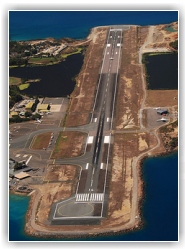 Saving $12m on an unnecessary runway extension
Saving $12m on an unnecessary runway extension
The owners of a tropical island resort had been advised by a major airline that their runway had to be lengthened as it could no longer accommodate a fully-laden Boeing 737-800 when the runway was wet. Whilst working as principal with a Sydney-based consulting practice, Bill Meeke was engaged to find out why this situation had arisen and to see if the major capital works (estimated at $12-million) could be avoided or contained.
The centre section of the runway had already been grooved to improve effectiveness in the wet, but the airline considered there was a predisposition to hydroplaning as a result of the inadequacy of this grooving. The cost of extending the runway by the suggested 200-metres was driven by the fact that it was bounded at both ends by bodies of water, including the Great Barrier Reef.
Research of data from Airservices Australia and the engineers retained by the airport owner supported the viability of the current runway. Boeing in Seattle was then asked to run some computer studies using a generic 737-800 on the wet grooved runway at the airport. CASA regulations (CASR Part 139) revealed that a wet grooved runway could be considered ‘dry’ if it had appropriate surface texture characteristics and provided there was no standing water or pooling.
Carefully targeted discussions with the airline’s flight operations engineering management uncovered the underlying reason for the problem. A few years earlier the airline changed its policy following an accident at another (overseas) airport where a Boeing 747 overran the runway during a tropical storm. The official investigation into that accident revealed many contributing factors including one revelation that the runway was not grooved.
The airline later found that another major airport had also not been cleaning its runway grooving and, on this basis, it decided to change its policy in respect of a wet grooved runway being considered ‘dry’ if it could not rely on the grooving being clean. In most airports this would have made little tangible difference as their runways were long enough to accommodate the change in policy. This was not the case at this airport though.
Positive negotiations with the airline’s technical management and senior pilots led to an agreement that if they could be assured the runway grooving was optimal at all times they would be agreeable to a reinstatement of the previous policy that allowed ‘credit’ for the runway grooving.
A cost-effective cleaning process was devised that enabled these guarantees to be made, enabling the airport to return to full productivity without the need to spend $12-million in avoidable upgrade work.
